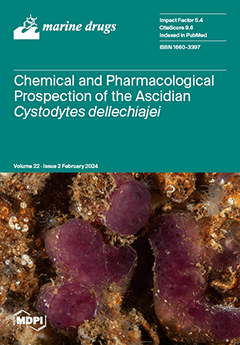Although melanin protects against ultraviolet radiation, its overproduction causes freckles and senile lentigines. Recently, various biological effects of metabolites derived from marine microorganisms have been highlighted due to their potential for biological and pharmacological applications. In this study, we discovered the anti-melanogenic effect of
Bacillus sp. APmarine135 and verified the skin-whitening effect. Fractions of APmarine135 showed the melanin synthesis inhibition effect in B16 melanoma cells, and 2,4,6-triphenyl-1-hexene was identified as an active compound. The melanogenic capacity of 2,4,6-triphenyl-1-hexene (
1) was investigated by assessing the intracellular melanin content in B16 cells. Treatment with 5 ppm of 2,4,6-triphenyl-1-hexene (
1) for 72 h suppressed the α-melanocyte-stimulating hormone (α-MSH)-induced intracellular melanin increase to the same level as in the untreated control group. Additionally, 2,4,6-triphenyl-1-hexene (
1) treatment suppressed the activity of tyrosinase, the rate-limiting enzyme for melanogenesis. Moreover, 2,4,6-triphenyl-1-hexene (
1) treatment downregulated tyrosinase, Tyrp-1, and Tyrp-2 expression by inhibiting the microphthalmia-associated transcription factor (MITF). Furthermore, 2,4,6-triphenyl-1-hexene (
1) treatment decreased the melanin content in the three-dimensional (3D) human-pigmented epidermis model MelanoDerm and exerted skin-whitening effects. Mechanistically, 2,4,6-triphenyl-1-hexene (
1) exerted anti-melanogenic effects by suppressing tyrosinase, Tyrp-1, and Tyrp-2 expression and activities via inhibition of the MITF. Collectively, these findings suggest that 2,4,6-triphenyl-1-hexene (
1) is a promising anti-melanogenic agent in the cosmetic industry.
Full article






